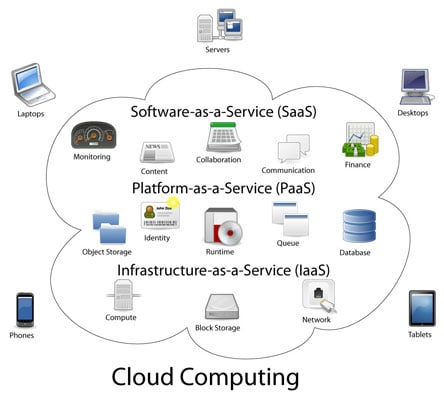- Software-as-a-Service (SaaS)
- Platform-as-a-Service (PaaS)
- Infrastructure-as-a-Service (IaaS)

Cloud Computing Service Models.
Software-as-a-service (SaaS)
A SaaS service model is where software application is paid for on a subscription basis and installed from the cloud provider's datacenter. Office 365 is an example of a SaaS model where all your collaboration and productivity applications are bundled together as part of your subscription. You don't have to run your own email servers, for example, nor do you need to maintain and update the servers. For desktop applications like Office Pro Plus, you can install the software from a web-based portal instead of buying the packaged software from a store. After you've installed the software, updates and bug fixes automatically are installed in the background.Platform-as-a-service (PaaS)
In a platform-as-a-service (PaaS) service model, developers can create online applications (apps in short) in platforms provided by the PaaS provider. The developers develop their own code for the apps, store it in the PaaS provider's datacenter, then publish the apps. They don't have to worry about planning for capacity, security, or managing the hardware—the PaaS provider does that.For example, if you've played Angry Birds on your Android phone, it may interest you to know that the publishers used Google App Engine as a PaaS solution to make their addicting games available to millions of fans without worrying about scaling the app automatically to match the amount of traffic at any given time.
Infrastructure-as-a-service (IaaS)
In an infrastructure-as-a-service (IaaS) service model, organizations have access to computing power and storage capacity, using a cloud provider's hardware. This enables them to have control over the infrastructure and run applications in the cloud at a reduced cost. The organization, however, is responsible for managing and updating the operating system running the applications.While capacity planning, security, and hardware management is the responsibility of the IaaS provider (similar to PaaS), it is the organization's job to monitor the performance of their apps and/or add more resources to meet the demand. Amazon Web Services offer several IaaS cloud hosting products that can be purchased by the hour. Rackspace is another player in the IaaS market offering managed and cloud hosting services. Microsoft Azure (formerly known as Windows Azure) started out as a PaaS solution, but extended its services to include IaaS capabilities.

